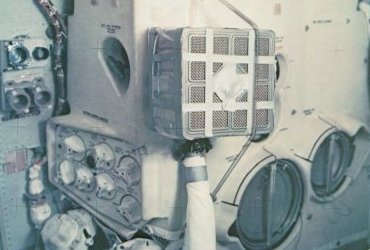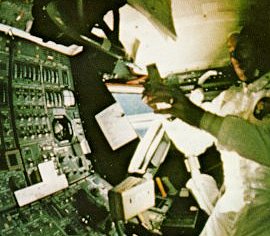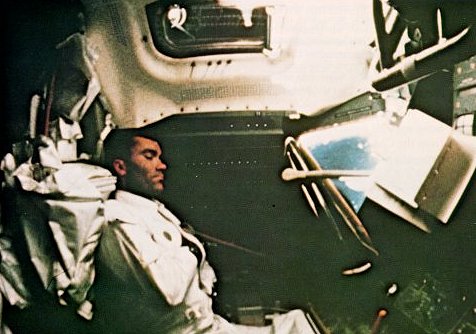
A SQUARE PEG IN A ROUND HOLE
We would have died of the exhaust from our own lungs if Mission Control hadn't come up with a marvelous fix. The trouble was the square lithium hydroxide canisters from the CM would not fit the round openings of those in the LM environmental system. After a day and a half in the LM a warning light showed us that the carbon dioxide had built up to a dangerous level, but the ground was ready. They had thought up a way to attach a CM canister to the LM system by using plastic bags, cardboard, and tape- all materials we had on board. Jack and I put it together: just like building a model airplane. The contraption wasn't very handsome, but it worked. It was a great improvisation- and a fine example of cooperation between ground and space.The big question was, "How do we get back safely to Earth?" The LM navigation system wasn't designed to help us in this situation. Before the explosion, at 30 hours and 40 minutes, we had made the normal midcourse correction, which would take us out of a free-return-to-Earth trajectory and put us on our lunar landing course. Now we had to get back on that free-return course. The ground-computed 35-second burn, by an engine designed to land us on the Moon, accomplished that objective 5 hours after the explosion.

|
| "Backroom" experts at Mission Control worked many hours to devise the fix that possibly kept the astronauts from dying of carbon dioxide. CapCom Joe Kerwin led Astronaut Swigert, step by step, for an hour to build a contraption like the one the experts had constructed on Earth. It involved stripping the hose from a lunar suit and rigging the hose to the taped-over CM double canister, using the suit's fan to draw carbon dioxide from the cabin through the canister and expel it back into the LM as pure oxygen. |

|
| Emergency scrubbers were built by Swigert and Haise. Photo above shows Swigert sitting next to a tapedover double canister and holding one end of a suit nozzle while Fred Haise used both his hands to manipulate the long hose. Underneath the canister is a "mailbox" built of arched cardboard, which was covered by a plastic bag. When Lovell later saw the rig put together on Earth, he said, "It looks just like the one we mode." It saved the astronauts from possible death from carbon dioxide. |
As we approached the Moon, the ground informed us that we would have to use the LM descent engine a second time; this time a long 5-minute burn to speed up our return home. The maneuver was to take place 2 hours after rounding the far side of the Moon, and I was busy running down the procedures we were to use. Suddenly, I noticed that Swigert and Haise had their cameras out and were busy photographing the lunar surface. I looked at them incredulously and said, "If we don't make this next maneuver correctly, you won't get your pictures developed!" They said, "Well, you've been here before and we haven't." Actually, some of the pictures these tourists took turned out to be very useful.
It was about this time that I said, "Boys, take a good look at the Moon. It's going to be a long time before anybody gets up here again." Later on I was accused of sabotaging Apollo; poor Dr. Paine had to explain that I didn't really mean it, and the space program would go on. The Senate Space Committee asked me about it a week after we got back. Actually, I didn't mean that remark to be public. (I later learned that, unknown to us, we had had a hot mike for about 45 minutes.) Nonetheless, it was 9 months before Apollo 14 was launched.
We had many crises on Apollo 13, but the biggest heart- stopper has hardly been noticed, partly because the transcription released to the press was garbled, and partly because there wasn't much point in talking about a crisis that had been averted earlier. It occurred prior to the second maneuver I mentioned earlier; we called it P.C. + 2 (pericynthian 2 hours).
We had transferred the CM platform alignment to the LM. but we had to make sure that this alignment was accurate before we made the long P.C. + 2 burn. Ordinarily it is simple to look through the sextant device, called the Alignment Optical Telescope, find a suitable navigation star, and with the help of our computer verify the guidance platform's alignment. But traveling with us was a swarm of debris from the ruptured service module. The sunlight glinting on these bits of junk- I called them false stars- made it impossible to sight a real star.

| Without a course correction, the returning spacecraft would have missed the Earth completely. Inertial references were stored in the guidance platform, but sightings an the Sun gave the astronauts confidence that the crucial burn would be properly oriented. |

| In the darkened, power-short spacecraft, temperature dropped to 38° F. Lovell and Haise donned their lunar boots, Swigert an extra suit of underwear. Water condensed on the cabin walls and windows frosted. Food was refrigerator-cold. |
So what to do? If we couldn't verify the accuracy of the alignment, we didn't have a way to make an accurate burn, or to align the CM platform for reentry. In other words, the ground would have no accurate way to tell us the correct attitude to make the proper maneuvers to return home.
A genius in Mission Control came up with the idea of using the Sun to check the accuracy of our alignment. No amount of debris could blot out that star! Its large diameter could result in considerable error, but nobody had a better plan.
I rotated the spacecraft to the attitude Houston had requested. If our alignment was accurate, the Sun would be centered in the sextant.

|
| Haise dozes with his hands restrained to keep his weightless arms from flopping about. In the cold gloom, one crew member stayed on watch at all times. Stay-awake pills helped during the final hours as the Earth came whistling at them like a freight train. |
When I looked through the AOT, the Sun just had to be there. It really had to be. And it was. At 73:46 hours the air-to-ground transcript sounds like a song from "My Fair Lady":
Lovell: O.K. We got it. I think we got it. What diameter was it?
Haise: Yes. It's coming back in. Just a second.
Lovell: Yes, yaw's coming back in. Just about it.
Haise: Yaw is in....
Lovell: What have you got?
Haise: Upper right corner of the Sun....
Lovell: We've got it!
If we raised our voices, I submit it was justified.
I'm told the cheer of the year went up in Mission Control. Flight Director Gerald Griffin, a man not easily shaken, recalls: "Some years later I went back to the log and looked up that mission. My writing was almost illegible I was so damned nervous. And I remember the exhilaration running through me: My God, that's kinds the last hurdle -- if we can do that, I know we can make it. It was funny, because only the people involved knew how important it was to have that platform properly aligned." Yet Gerry Griffin barely mentioned the alignment in his change-of- shift briefing -- "That check turned out real well" is all he said an hour after his penmanship failed him Neither did we, as crew members, refer to it as a crisis in our press conference nor in later articles.
The alignment with the Sun proved to be less than a half a degree off. Hallelujah Now we knew we could do the 5-minute P.C. + 2 burn with assurance, and that would cut the total time of our voyage to about 142 hours. We weren't exactly home free: we had a dead service module, a command module with no power, and a lunar module that was a wonderful vehicle to travel home in, but unfortunately didn't have a heat shield required to enter the Earth's atmosphere. But all we needed now was a continuation of the expertise we seemed blessed with, plus a little luck.
| Next |